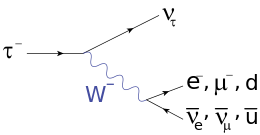تاو (جسيم)
| تركيب | Elementary particle |
|---|---|
| المجموعة | Lepton |
| الجيل | Third |
| التفاعل | Gravity, Electromagnetic, Weak |
| جسيم مضاد | Antitau (τ+) |
| اُكتـُشـِف | Martin Lewis Perl et al. (1975)[1][2] |
| الرمز | τ− |
| الكتلة | 1776.82±0.16 MeV/c2[3] |
| الكتلة الكهربائية | −1 e[3] |
| شحنة اللون | None |
| سپين | 1⁄2[3] |
تاو tau (τ)، ويسمى أيضاً لپتون تاو tau lepton، جسيم تاو أو تاوون tauon، هو جسيم ابتدائي مشابه للإلكترون، ذو شحنة كهربائية سالبة و سپين قدرها 1⁄2. Together with the electron, the muon, and the three neutrinos, it is classified as a lepton. Like all elementary particles, the tau has a corresponding antiparticle of opposite charge but equal mass and spin, which in the tau's case is the antitau (also called the positive tau). Tau particles are denoted by τ− and the antitau by τ+.
Tau leptons have a lifetime of 2.9×10−13 s and a mass of 1777 MeV/c2 (compared to 105.7 MeV/c2 for muons and 0.511 MeV/c2 for electrons). Since their interactions are very similar to those of the electron, a tau can be thought of as a much heavier version of the electron. Because of their greater mass, tau particles do not emit as much bremsstrahlung radiation as electrons; consequently they are potentially highly penetrating, much more so than electrons. However, because of their short lifetime, the range of the tau is mainly set by their decay length, which is too small for bremsstrahlung to be noticeable: their penetrating power appears only at ultra high energy (above PeV energies).[4]
وكما في حالة اللپتونات المشحونة الأخرى، فإن التاو له قرين هو نيوترينو تاو. ونيوترينو تاو يـُرمز له بالاسم ντ.
وقد حصل مارتن لويس پرل على جائزة نوبل في الفيزياء عام 1995 لاكتشافه جسيم دون ذري أسماه "تاو" وهو لپتون ذو كتلة بشحنة سالبة. التاو، الذي اكتشفه في منتصف السبعينات، كان أول دليل على وجود "الجيل الثالث" من الجسيمات الأساسية. وهو ابن عم فائق الثقل للإلكترون، مشابه له تماماً في كل الأوجه إلا أن التاو أثقل من الإلكترون بنحو 3,500 مرة، ويبقى متواجداً لأقل من واحد على تريليون من الثانية، بينما الإلكترون جسيم مستقر.
اضمحلال تاو
طالع أيضاً
الهامش
- ^
L.B. Okun (1980). Quarks and Leptons. V.I. Kisin (trans.). North-Holland Publishing. p. 103. ISBN [[Special:BookSources/0-444-86294-7 قالب:Please check ISBN|0-444-86294-7 [[:قالب:Please check ISBN]]]].
{{cite book}}: Check|isbn=value: invalid character (help) - ^ خطأ استشهاد: وسم
<ref>غير صحيح؛ لا نص تم توفيره للمراجع المسماةPerl1975 - ^ أ ب ت K. Nakamura et al. (Particle Data Group) (2010). "Review of Particle Physics". Journal of Physics G. 37 (7A): 525–553. Bibcode:2010JPhG...37g5021N. doi:10.1088/0954-3899/37/7A/075021.
{{cite journal}}:|chapter=ignored (help); More than one of|pages=and|page=specified (help) - ^
D. Fargion, P.G. De Sanctis Lucentini, M. De Santis, M. Grossi (2004). "Tau Air Showers from Earth". The Astrophysical Journal. 613 (2): 1285. arXiv:hep-ph/0305128. Bibcode:2004ApJ...613.1285F. doi:10.1086/423124.
{{cite journal}}: CS1 maint: multiple names: authors list (link)
وصلات خارجية
- Nobel Prize in Physics 1995
- Perl's logbook showing tau discovery
- A Tale of Three Papers gives the covers of the three original papers announcing the discovery.
